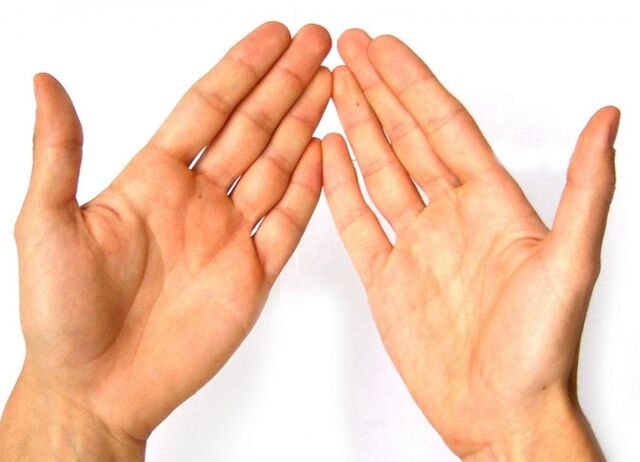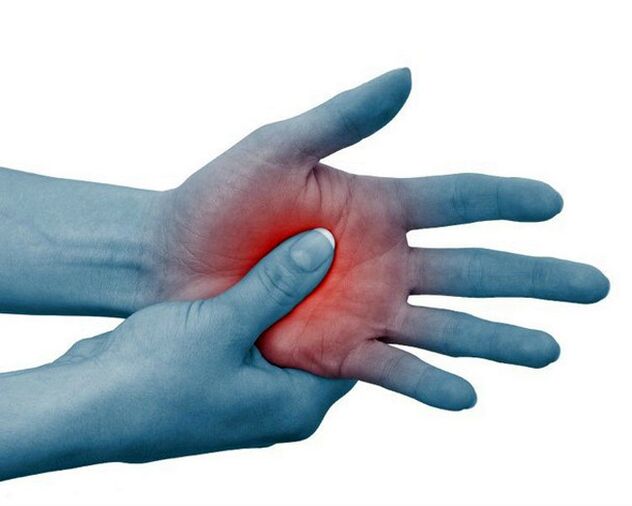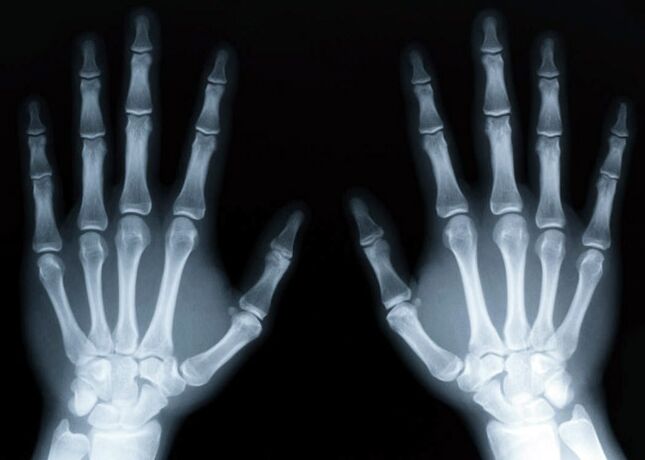Often, patients complain that their finger joints hurt. All pathologies have expressed certain symptoms, so the specialist will quickly make a diagnosis and prescribe the correct treatment.
Rheumatoid arthritis
Rheumatoid arthritis is a serious disease accompanied by an inflammatory process. It causes joint pain and deformity. Pathology usually occurs in people over 30 years old. Women experience it 3 times more often than men.

Rheumatoid arthritis appears suddenly and is associated with impaired immune system function. In this disease, the immune cells mistake the joint cells for viruses or bacteria and try to eliminate them. The destruction process can last for years.
The following symptoms of the disease are distinguished:
- severe joint pain, worse at night or in the morning;
- stiffness in the joints after sleep;
- high body temperature;
- sleep disorders;
- fatigue quickly;
- decreased appetite;
- sudden weight loss;
- formation of nodules in the elbow area.
Rheumatoid arthritis develops due to the following factors:
- sore throat or previous flu;
- joint injuries;
- infectious pathology;
- long-term stress and depression;
- genetic predisposition.
A distinctive feature of rheumatoid arthritis from arthrosis is a decrease in pain during exercise. If the finger joint of the right hand hurts and swells, then the same symptoms appear in the left hand. Over time, this disease can affect other joints.

If you start therapy at an early stage, you can avoid joint deformation and destruction.
Nuance!Breastfeeding for two years reduces the risk of rheumatoid arthritis in women by 2 times.
Treatment
Modern methods of treating rheumatoid arthritis include the following:
- aurotherapy;
- cytostatic;
- taking antimalarial drugs;
- sulfonamides;
- D-penicillamine.
On average, even an experienced rheumatologist takes about 6 months to choose the right treatment method, because he examines the patient's characteristics and his tolerance to drugs.
What is aurotherapy?
Aurotherapy involves taking medicine that contains gold salts.
Doctors recommend using gold preparations in the early stages of the disease. With their help, it is possible to achieve a positive effect in the treatment of acute, rapidly developing pathologies with severe pain and early degenerative changes in the joints. Gold-based drugs are prescribed to patients in cases where non-steroidal anti-inflammatory drugs do not reduce their condition.
The main advantage of aurotherapy is that it can be used for concomitant inflammatory pathologies and the presence of malignant tumors. Also, during research, scientists found that gold salt actively fights fungi and some bacteria, including Helicobacter pylori.
The course of treatment with gold preparation is 2-3 months. If during this period the patient's condition does not improve, then this technique is canceled.
Notes!Many people experience a relapse of rheumatoid arthritis sometime after gold treatment. A rheumatologist can re-prescribe aurotherapy. Sometimes such treatment can last for years if it does not have a negative effect on other organs.
Is cytostatic therapy effective?
To eliminate the symptoms of rheumatoid arthritis, it is customary to use cytostatics.
Since this disease is of autoimmune origin, it is not surprising that doctors prescribe immunosuppressants. Their main advantage is their high efficiency at relatively low doses. Patients with rheumatoid arthritis are prescribed 5 or even 20 times less cytostatic doses than patients with cancer. Medicines have proven themselves in the fight against severe forms of the disease with a high degree of development.
Another advantage of treatment with immunosuppressants is the minimal number of side effects. Quite rarely, patients complain of the following symptoms:
- rash;
- intestinal dysfunction;
- shivering;
- difficulty urinating.
If the drug is stopped or the doctor adjusts the dose, the side effects quickly disappear. The course of treatment is 1 month.
Treatment of finger joints with antimalarial drugs
Treatment of rheumatoid arthritis with antimalarial drugs is very rare. The main advantage of this treatment is the good tolerance of the drugs. A significant disadvantage of this treatment is that antimalarial drugs act slowly. Their effect is noticeable after 6-12 months, but the therapeutic effect is relatively weak.
Do sulfonamides help with rheumatoid arthritis?
Drugs from the sulfonamide group are successfully used to treat finger pain. Their advantages include:
- Good tolerance.
- Low level of complications, if any.
- Affordable price.
The disadvantage of these drugs is their slow action. Positive effects can be seen only 3 months after the start of the therapy course.
How to treat diseases with D-penicillamine?
If the patient is suitable for treatment with gold preparations or the use of cytostatics, then it is not necessary to prescribe D-penicillamine. It is much lower than the listed treatment methods in terms of effectiveness, but significantly exceeds them in the number of side effects, frequency of occurrence and level of complications. Therefore, treatment with D-penicillamine is used in cases where the patient does not tolerate gold salts and cytostatics well.
D-penicillamine is effectively used in patients with complications of the heart, respiratory system or kidneys. It should be taken for 3 to 5 years, then a break will be required for several years, after which the course must be repeated.
Gout - symptoms and treatment
One of the dangerous diseases of the joints and tissues is gout. It occurs as a result of metabolic disorders in the body. Gout is characterized by an increase in the amount of uric acid in the lymph.
Symptoms of the disease include:
- inflammation of the big toe joint;
- severe pressing pain in the morning or at night;
- increased body temperature;
- redness of the skin;
- tumors on the legs or arms.
If treatment is not started immediately, the patient may develop gouty arthritis. Possible complications also include urolithiasis and kidney failure, which can lead to death.

To treat gout, non-steroidal anti-inflammatory drugs are used for 1-2 weeks.
To reduce the concentration of uric acid in the body quickly, anti-gout drugs are prescribed.
To eliminate the acute symptoms of gout, experts prescribe drugs based on the alkaloids of the majestic lily family corms. Glucocorticoids are used to relieve swelling and pain. These drugs quickly remove inflammation, but have a negative effect on the immune system.
Psoriatic arthritis
About 15% of patients diagnosed with psoriasis have problems with their finger joints. The symptoms of this disease are:
- joint deformation;
- pain syndrome at night;
- numbness of limbs;
- skin discoloration in burgundy color at the site of disease development;
- finger swelling;
- limited mobility.
Most patients with psoriatic arthritis experience damage to the nail plate. First, small holes form on its surface, then its color changes due to microcirculation disruption.
Often, pregnant women are diagnosed with psoriatic arthritis. This is due to the fact that this disease also originates from hormones, and a woman experiences hormonal changes in her body during pregnancy. Increased symptoms of arthritis in pregnant women are often associated with weight gain.
The following causes of psoriatic arthritis are identified:
- injury;
- severe stress and emotional stress;
- excessive physical activity;
- contagious disease;
- hereditary tendency.
The following groups of drugs are used to treat psoriatic arthritis:
- Non-steroidal drugs. Designed to eliminate inflammation and reduce pain.
- Glucocorticosteroids: injected into the joint cavity.
- Cytostatics from the group of folic acid antagonists: are the most popular systemic drugs.
- Immunosuppressants that act selectively on T-lymphocytes: used to slow down the changes that occur in bone and cartilage tissue.
For psoriatic arthritis, it is recommended to avoid alcoholic beverages, reduce the consumption of citrus fruits and smoked foods, and adhere to a low-calorie diet.
Osteoarthritis - how to treat it and what are the consequences of this disease?
Elderly people often complain that their finger joints are swollen. This may be one of the signs of osteoarthritis. This disease may appear for the following reasons:
- hormonal imbalance;
- genetic predisposition;
- occupational stress and injury;
- age-related metabolic disorders.
Joint pain can help identify the disease. An accurate diagnosis is made by a specialist after an X-ray and MRI examination.
Gymnastics will help alleviate the patient's condition. The training set is selected by the doctor, focusing on the individual characteristics of patients with osteoarthritis. Therapy also includes following a diet to reduce excess body weight, if any. You can't do it without thermal procedures. A paraffin bath is recommended, to which mineral oil should be added.
To eliminate pain and relieve swelling, non-steroidal anti-inflammatory drugs from the group of derivatives of propionic acid and acetylsalicylic acid are prescribed. Among analgesics, drugs from the anilide group are often used. A massage session will help warm your muscles and improve blood circulation.
If treatment is not started on time, the person will be unable to cope with daily activities in the future. In such cases, joint replacement surgery is unavoidable.
What is rhizarthrosis?
If the patient has pain in his thumb, this may indicate that he has rhizarthrosis. The reasons for this phenomenon may be:
- shared burden;
- past infectious diseases;
- injury;
- body hangover
Treatment of rhizarthrosis at stage 1-2 includes taking chondroprotectors. They activate the process of the appearance of new cartilage cells, which helps to get rid of this disease.
It is quite popular to use manual therapy to treat rhizarthrosis. The therapist can realign the changed joint, as a result of which the pain syndrome will disappear. In addition, you can massage the thumb to increase the tone of the cartilage tissue and increase joint mobility.

If the patient is diagnosed with rhizarthrosis of the 3rd degree, then intra-articular injection of hyaluronic acid is prescribed. It is also effective to use glucocorticosteroids and non-steroidal anti-inflammatory drugs. They increase blood flow to the affected joints, relieve pain, and relieve swelling.
Traditional medicine for finger pain
You can overcome pain not only with the help of drugs, but also by using folk remedies. For acute pain, it is effective to use a gauze bandage soaked in apple cider vinegar. To relieve swelling, compresses using baked onions or boiled potatoes are perfect. It is useful to warm the aching joints with hot sea salt and rub them with fir oil.
Colored
One common method of treatment is tincture. You can use vodka for preparation. You need to take 50 ml of vodka and 30 ml of valerian tincture, mix both components and add some red pepper. After 3 hours, moisten the cotton in the resulting mixture and apply it to the phalanx. Positive effects can be seen after a month of such treatment.
Another effective remedy is a tincture based on chestnut blossoms. It is enough to collect raw materials and mix them with vodka. Leave for 14 to 20 days. Rub the product when your fingers are numb and you feel pain. Instead of chestnut blossoms, it is allowed to use purple.
Ointment
If your joints hurt when you squeeze your fingers, you should use mustard and honey ointment. To prepare it, combine 5 g of mustard and 15 g of honey. Next, add 30 ml of olive oil, evaporate the mixture in a water bath to a thick consistency, cool and use every day to treat the affected joints.
For pain in the joint of the index finger of the right hand, an ointment based on bay leaves and juniper needles is recommended. Both components should be mixed in equal proportions, then add 50 g of butter. You can use the ointment during regular joint massage.

























